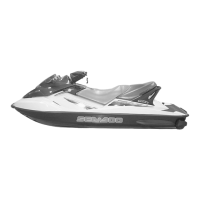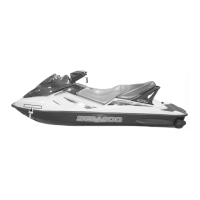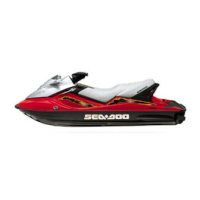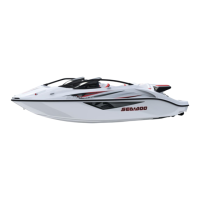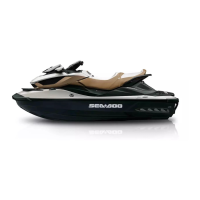Section 06 ELECTRICAL SYSTEM
Subsection 02 (CHARGING SYSTEM)
EXAMPLE NO. 1 EXAMPLE NO. 2
TEMPERATURE ABOVE 21°C(70°F):
Hydrometer reading: 1.250
Electrolyte temperature: - 1°C(30°F)
Subtract .016 Sp. Gr.
Corrected Sp. Gr. is 1.234
TEMPERATURE ABOVE 21°C(70°F):
Hydrometer reading: 1.235
Electrolyte temperature: 38°C(100°F)
Add .012 Sp. Gr.
Corrected Sp. Gr. is 1.247
SPECIFIC GRAVITY READING USING
A HYDROMETER
ELECTROLYTE TEMPERATURE
STATE OF
CHARGE
27°C(80°F) 4°C(40°F)
100%
1.26/1.27 1.27/1.28
75%
1.21/1.22 1.22/1.23
50% 1.16/1.17 1.17/1.18
25%
1.12/1.13 1.13/1.14
0%
1.10 or less 1.11 or less
Load Test
This is the best test of battery condition under a
starting load. Use a load testing device that has
an adjustable load.
Apply a load of 3 times the ampere-hour rating of
the battery. At 14 seconds into the test, check
battery voltage; if battery is in good condition, it
will have at least 10.5 Vdc.
Battery Storage
CAUTION: Battery storage is critical for battery
life. Regularly charging the battery during stor-
age will prevent cell sulfation. Keeping the bat-
tery in vehicle for storage may lead to con-
tacts degradation/corrosion and case damage
if freezing occurs. A discharged battery will
freeze and break in area where freezing point
is experienced. Electrolyte leakage will dam-
age surrounding parts. Always remove battery
from vehicle for storage and regularly charge
to keep an optimal condition.
Disconnect and remove battery from watercraft as
explained in REMOVAL.
Check electrolyte level in each cell, add distilled
water up to upper level line.
CAUTION: Do not overfill.
The battery must always be stored in fully charged
condition. If required, charge until specific gravity
of 1.265 is obtained.
CAUTION: Battery electrolyte temperature
must not exceed 50°C (122°F). The casing
should not feel hot.
Clean battery terminals and cable connections us-
ing a wire brush. Apply a light coat of dielectric
grease on terminals.
Clean battery casing and caps using a solution of
baking soda and water.
CAUTION: Do not allow cleaning solution to en-
ter battery.
Rinse battery with clear water and dry well using
a clean cloth.
Store battery in a cool dry place. Such conditions
reduce self-discharging and keep fluid evaporation
to a minimum. Keep battery away from dew, high
moisture and direct sunlight.
During the storage period, recheck electrolyte
level and specific gravity readings at least every
month. If necessary, keep the battery at its upper
level line and near full charge as possible (trickle
charge).
Activation of a New Battery
WARNING
Never charge or boost battery while installed
in watercraft.
Perform the following operations anytime a new
battery is to be installed.
– Remove the sealing tube from the vent elbow.
WARNING
Failure to remove the sealing tube could re-
sult in an explosion.
– Remove caps and fill battery to UPPER LEVEL
line with electrolyte (specific gravity: 1.265 at
21°C(70°F)).
NOTE: This battery may fill slower than others due
to the anti-spill check ball design.
smr2005-016 159
